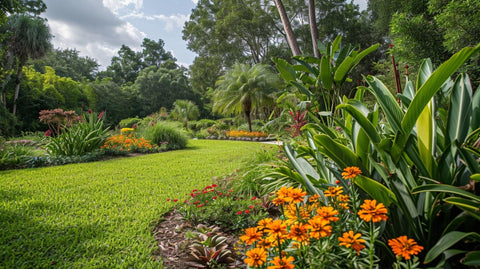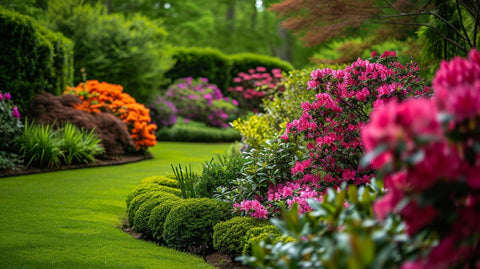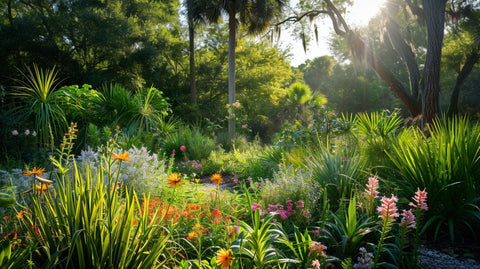When it comes to landscaping in Florida, selecting the right plants is crucial to creating a vibrant and thriving outdoor space. The unique climate of Florida poses certain challenges, but with the wide variety of native plants available, you can easily transform your garden into a stunning oasis. In this article, we will explore the benefits of using Florida plants for landscaping, key considerations when selecting plants, popular plant options, design ideas, and maintenance tips.
Benefits of Using Florida Plants for Landscaping

Advantages of Using Native Plants
One of the major benefits of using Florida plants for landscaping is that native plants are well-suited to the local climate. They have evolved to thrive in the specific conditions of Florida, making them low maintenance and drought-resistant. This means less water usage and reduced need for fertilizers or pesticides, making it an eco-friendly choice. Additionally, native plants attract native wildlife, such as butterflies and birds, creating a vibrant and sustainable ecosystem in your own backyard.
Diversity of Plant Species in Florida
Florida's rich biodiversity offers a plethora of plant species to choose from when designing your landscape. From vibrant flowers to lush shrubs and towering trees, the options are endless. This diversity allows for a wide range of design possibilities, whether you prefer a tropical theme with palm trees and exotic blooms or a coastal-inspired design with beach-friendly plants.
Key Considerations when Selecting Florida Plants
Climate Requirements and Hardiness Zones
Understanding Florida's specific climate zones is essential when selecting plants for your landscape. The state is divided into several hardiness zones, each with its own unique temperature range and environmental conditions. By choosing plants that are suitable for your specific zone, you can ensure their survival and maximize their growth potential.
Soil Conditions and Water Requirements
Florida has a diverse range of soil types, including sandy, limestone-based, and muck soils. It is important to assess the soil conditions in your area and choose plants that are compatible with the soil type. Additionally, understanding the water requirements of different plants is crucial for their success. Proper irrigation techniques and soil improvement strategies can help create the ideal growing conditions for your chosen plants.
Popular Florida Plants for Landscaping
Showcase Native Flowering Plants
When it comes to adding pops of color to your landscape, Florida offers a stunning array of native flowering plants. Bougainvillea, hibiscus, and azaleas are just a few examples of the vibrant options available. These flowering plants not only add visual appeal but also attract pollinators, such as bees and butterflies. Consider incorporating them into your landscape design for a burst of color and wildlife activity.
Explore Native Trees and Shrubs
Native trees and shrubs not only provide shade and privacy but also add structure and character to your landscape. Live oak, sabal palm, and magnolia are popular choices that thrive in the Florida climate. These trees and shrubs offer various benefits, including erosion control, providing habitat for birds, and contributing to overall biodiversity. Determine the ideal planting locations for these native beauties to create a visually stunning and ecologically beneficial landscape.
Design Ideas and Tips for Incorporating Florida Plants
Different Landscaping Styles
Florida's climate lends itself well to different landscaping styles. If you're aiming for a tropical theme, palm trees and lush foliage can help create that vacation-like ambience right in your backyard. On the other hand, if you prefer a coastal-inspired design, incorporating plants that thrive in sandy soils and can withstand salt exposure will give your landscape a beachy vibe. Consider your personal preferences and the surrounding environment to determine which style suits your space best.
Arranging and Grouping Plants Effectively
When arranging plants in your landscape, consider their height, color palette, and bloom times. Varying the heights of plants creates visual interest and ensures a balanced composition. Select plants with complementary colors that create a harmonious palette throughout the year. Additionally, plant species with staggered bloom times to ensure vibrant blooms throughout the seasons. By strategically placing plants to create focal points and visual interest, you can elevate the overall aesthetic of your landscape design.
Maintenance and Care for Florida Plants
General Care Guidelines
Maintaining the health and vitality of your Florida plants requires proper care and maintenance. Regular pruning techniques help promote healthy growth and maintain desired shapes. Understand the fertilization needs of different plants and follow best practices to provide the necessary nutrients. Additionally, staying vigilant against common pests and diseases in Florida, such as whiteflies or citrus greening, is crucial. Utilize organic and eco-friendly solutions whenever possible to protect both your plants and the environment.
Conclusion
Florida plants offer a range of benefits for landscaping, from their ability to thrive in the state's unique climate to their diverse range of species. By selecting native plants, you not only create a low maintenance and eco-friendly landscape but also support the local ecosystem. With careful consideration of climate requirements, soil conditions, and design ideas, you can create a stunning outdoor space that showcases the beauty of Florida. Don't hesitate to seek professional advice or visit local nurseries to explore the vast variety of native plants and further enhance your landscape design.






























Comments (0)
There are no comments for this article. Be the first one to leave a message!